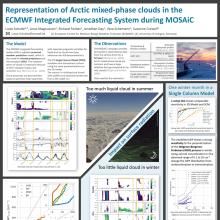Evaluation of mixed-phase microphysics in Arctic clouds in the ECMWF IFS during MOSAiC
Luise
Schulte
ECMWF / University of Cologne
Poster
Low-level mixed-phase clouds occur frequently in the Arctic, and the ECMWF Integrated Forecasting System (IFS) underestimates their occurrence at cold temperatures, similar to many other large-scale models.
The challenge for the representation of mixed-phase clouds is the complexity of microphysical processes that occur.
The IFS uses a (comparatively) simple microphysics scheme (single moment), and although a more complex representation of microphysics could be implemented, it is not clear what level of complexity is required.
We evaluate the representation of Arctic mixed-phase clouds in the IFS using observational data from the MOSAiC campaign and test the sensitivity to processes that convert supercooled liquid water to ice in single column and full global model simulations.
Our results show that with a small parametrisation change we can improve the representation of supercooled liquid water in winter Arctic mixed-phase clouds much closer to observations. Furthermore, the analysis of the temperature dependence of the implemented processes indicates the importance of explicitly representing the heterogeneous freezing process.
This shows how the combination of observations and detailed sensitivity tests can help to improve the representation of Arctic mixed-phase clouds and increase the physical realism of mixed-phase microphysics in the IFS.
The challenge for the representation of mixed-phase clouds is the complexity of microphysical processes that occur.
The IFS uses a (comparatively) simple microphysics scheme (single moment), and although a more complex representation of microphysics could be implemented, it is not clear what level of complexity is required.
We evaluate the representation of Arctic mixed-phase clouds in the IFS using observational data from the MOSAiC campaign and test the sensitivity to processes that convert supercooled liquid water to ice in single column and full global model simulations.
Our results show that with a small parametrisation change we can improve the representation of supercooled liquid water in winter Arctic mixed-phase clouds much closer to observations. Furthermore, the analysis of the temperature dependence of the implemented processes indicates the importance of explicitly representing the heterogeneous freezing process.
This shows how the combination of observations and detailed sensitivity tests can help to improve the representation of Arctic mixed-phase clouds and increase the physical realism of mixed-phase microphysics in the IFS.

Schulte-Luise-poster.pdf
(8.36 MB)
Meeting homepage
